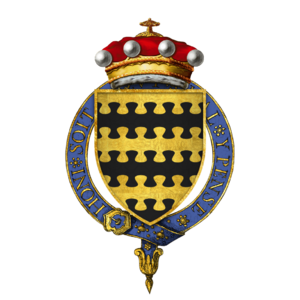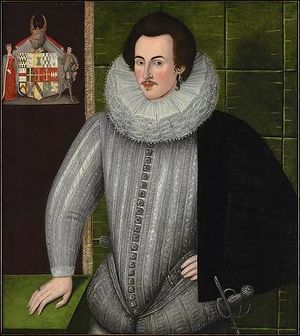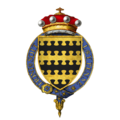Charles Blount, 8th Baron Mountjoy facts for kids

Charles Blount, 1st Earl of Devonshire (pronounced Blunt; 1563 – 3 April 1606) was an English nobleman and soldier. He served as a top leader in Ireland for Queen Elizabeth I and later for King James I.
He became the 8th Baron Mountjoy in 1594. He led the English army during the last years of a big conflict in Ireland called Tyrone's Rebellion. He won an important battle at Kinsale. He also captured the main base of the rebel leader, Tyrone. Peace was then made with the Treaty of Mellifont in 1603.
Contents
Early Life and Career
Charles Blount was born in 1563. He was the second son of James, 6th Baron Mountjoy. He became the 8th Baron Mountjoy after his older brother passed away.
He was known for being handsome and charming. This helped him gain the favor of Queen Elizabeth I. He also became friends with Lord Essex.
Charles Blount was elected to the House of Commons (a part of the English Parliament) several times. He represented areas like St Ives and Bere Alston. In 1594, he joined the House of Lords, which is another part of Parliament.
Between 1586 and 1598, Charles spent much time serving in the military in other countries. He fought in the Netherlands and Brittany. He also joined an important sea trip to the Azores in 1597 with Lord Essex and Sir Walter Raleigh.
Leading in Ireland
Charles Blount arrived in Ireland on February 24, 1600. He was sent as the Lord Deputy. His main job was to end the Nine Years' War. This was a long and difficult conflict.
The main rebel leader was Hugh O'Neill, Earl of Tyrone. Even O'Neill noted Mountjoy's polite manners. But Mountjoy proved to be a very skilled military leader.
Mountjoy's Military Strategy
In early 1600, Mountjoy sent Sir Henry Docwra with an army. They landed in Culmore to build a fort. This fort would control the area around Lough Foyle. Mountjoy also moved his own army from Dublin to Newry. This stopped O'Neill from sending many troops to fight Docwra.
Mountjoy learned from past mistakes. He made sure to clear and protect important routes. For example, he secured the Moyry Pass. This pass had always been a problem for English forces. He also set up military posts at Mountnorris and Armagh.
On July 13, 1601, Mountjoy's army faced O'Neill's forces at the River Blackwater. O'Neill's forces eventually pulled back. Mountjoy then took control of the ruined Blackwater fort. O'Neill had destroyed this fort in 1595.
By July 15, 1601, Mountjoy had secured the surrender of one of O'Neill's allies. That month, Mountjoy built a new fort near the old Blackwater fort.
Ending the War
Mountjoy told the English council that O'Neill was trying to stop his army from entering Tyrone. So, Mountjoy started a plan to burn large amounts of crops. This was meant to cause a famine. The idea was to force the rebels out of their hiding places.
Mountjoy continued to try and draw O'Neill's forces into battle. He moved supplies for the new fort from O'Neill's side of the river. He also burned more crops. More small fights happened between Mountjoy and O'Neill's forces in the summer of 1601.
Spanish forces landed in Munster in August 1601. This made Mountjoy move his army south. O'Neill stayed in his main area of Tyrone. The Spanish arrival led to the Battle of Kinsale in December. This battle was a major defeat for the rebels and their allies.
O'Neill had also moved south to help his allies. But after some big losses, he could not fight effectively. This was when Mountjoy marched into Tyrone again in the summer of 1602.
Mountjoy returned to the River Blackwater. He built a new fort there. This fort gave him safe access into Tyrone. O'Neill then burned his capital at Dungannon and fled.
As Mountjoy moved north through Tyrone, he built another fort. It was called Mountjoy Castle. He also named the new fort at the Blackwater "Charlemont Fort" after himself.
In Tyrone, Mountjoy carried out a campaign to weaken the rebels. His forces hunted rebels, destroyed crops, and burned homes. This was done to force O'Neill and his remaining allies to give up. Mountjoy also destroyed Tullyhogue Fort. This was a very important site for the O'Neill family.
On March 30, 1603, O'Neill made peace with Mountjoy. This was just six days after Queen Elizabeth died. They signed the Treaty of Mellifont. Mountjoy continued to serve in Ireland. He was given the higher title of Lord-Lieutenant from 1603 to 1604. He offered fair terms to the rebels. He also handled smaller uprisings in other cities calmly.
Changes in Ireland
As part of the Plantation of Ulster, some areas of Tyrone were changed. The barony of Loughinsholin became part of the new County Londonderry. Other parts were combined to create a new area called the barony of Mountjoy. This area was later joined with the barony of Dungannon.
Later Life and Legacy
When he returned to England, Lord Mountjoy became a judge for Sir Walter Raleigh in 1603. In the same year, King James I made him Master-General of the Ordnance. This was an important military role. The King also made him the Earl of Devonshire. He was given many large estates.
Mountjoy's work in Ireland helped set the stage for future events. After his death, in 1607, many Irish leaders left Ireland. This event is known as the flight of the Earls. This led to the Plantation of Ulster. This was a plan to settle more English and Scottish people in Ireland.
Lord Devonshire passed away on April 3, 1606, in London. He did not have any children who could inherit his titles. So, his noble titles ended when he died. A writer named John Ford wrote a long poem to honor Charles Blount after his death.
Family
Towards the end of his life, on December 26, 1605, Charles Blount married Lady Penelope. She was the sister of Lord Essex. They had been together for a long time. Their marriage was unusual for the time.
Charles Blount and Lady Penelope had several children together. These children were born before they were married. Charles Blount recognized them as his own. Their children included:
- Penelope Rich (born 1592)
- Mountjoy Blount, 1st Earl of Newport (1597–1666)
- Sir Saint John Blount (born 1597)
- Ruth Blount (1600–1694)
- Isabella (Elizabeth) Blount
- Charles Blount (1605–1627)
Images for kids
See also
 In Spanish: Charles Blount, VIII barón de Mountjoy para niños
In Spanish: Charles Blount, VIII barón de Mountjoy para niños
- Baron Mountjoy
- Blount baronets




